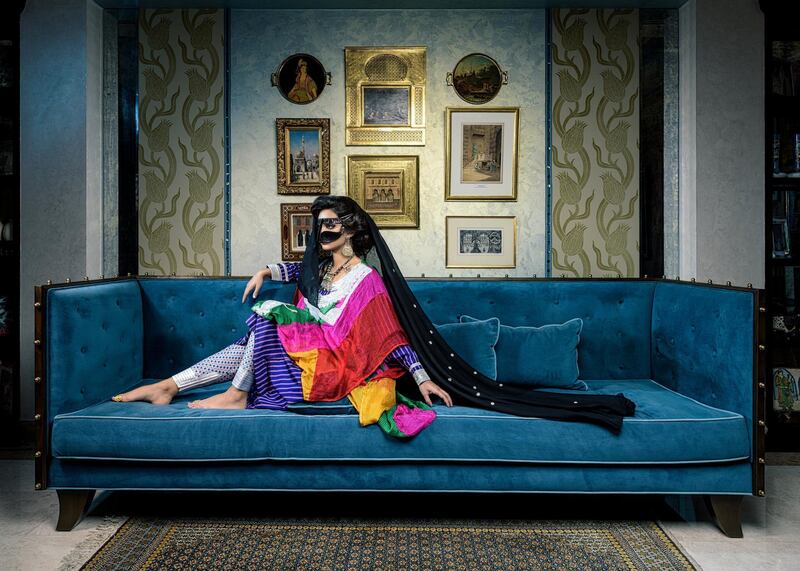Ask any woman what she was wearing at key points in her life, and she’ll probably be able to tell you. Just as photographs, artworks and other souvenirs can evoke memories, a woman’s wardrobe can catalogue her personal history, while also more broadly reflecting the life and times in which she lived.
Reem El Mutwalli, who has previously described herself as a “scholar who happens to design”, has gathered and curated a collection of more than 170 Emirati dresses, many of which have been worn by members of the UAE’s royal families. The gorgeous fabrics, colours, weaving, embroidery and embellishments of the Sultani collection (named after a striped opaque silk that is popular in the region), provide fascinating insight into the UAE’s identity.
With the aim of making these exquisite pieces accessible to a wider audience, and providing a window into "the expression of a society's character and history, indicating aspects of its culture, heritage and prevailing attitude", El Mutwalli recently collaborated with Omani photographer Issa Saleh Al Kindy, to produce a series of limited-edition photographic prints called The Sofa Series: Sultani. These feature four different pieces from the collection, complete with accessories, modelled by El Mutwalli's daughter Mae Noaf, seated on a velvet sofa in her mother's home.
“Both parties are avid connoisseurs of culture and art,” says the designer of the collaboration. “Both [of us] understand the imperative need to accurately document and preserve such garments. And we both appreciate that many lovers of art, UAE heritage and culture, would like to keep a token of such articles of history, but cannot possibly acquire the original garment,” she adds.
El Mutwalli has previously collaborated with artists, events and institutions on unique installations or exhibits featuring select pieces from the Sultani collection. The fragile and embellished nature of many of the fabrics mean that the number of displays, not to mention their duration, needs to be limited, in order to preserve this collection for future generations. "These are articles of delicate fabrics that are hard to collect, due to an earlier un-sedentary lifestyle," she says. "People here have a culture of giving away or recycling their old garments."
The dresses in the collection date from the early 1950s, and are a culmination of 25 years of El Mutwalli's efforts. Sultani fabric is unique and cannot be replicated. "It represents my humble appreciation and is an act of giving back to a culture that I grew up in, and a history I have individually witnessed," she explains.
Look 1: modern design
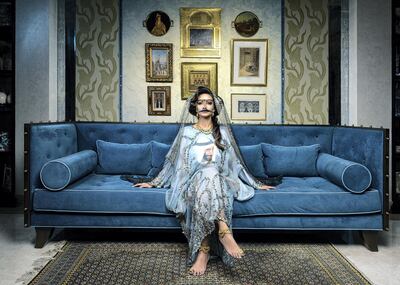
This dress began with a hand-painted portrait of Sheikh Zayed, the Founding Father, by Sheikha Alyazia bint Nahyan Al Nahyan, who was an aspiring artist at the time. Her mother, Sheikha Fakhira bint Saeed Al Nahyan, then designed the blue chiffon garment to complement the artwork, with the addition of detailed embroidery and embellishment work, which was carried out by skilled artisans. It provides an example of the unification of two traditional articles of dress (the thobe and the kandura) into one, which is the norm nowadays as the kandura evolved into the inner slip of the thobe and is generally attached to it, at the neckline. It was worn on many occasions by Sheikha Alyazia and was ultimately donated to the Sultani collection.
Look 2: riot of colour
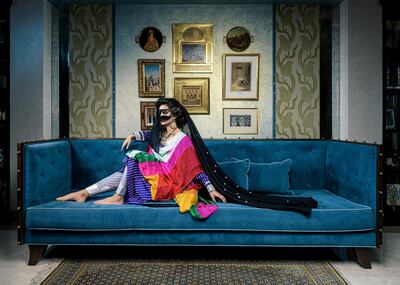
This ensemble embodies key elements of traditional UAE dress and dates back to around 1984. A burqa or face mask covers most of the wearer’s facial features. The shayla is made from black cotton gauze, which reflects an earlier style of this type of headscarf. Here, it engulfs most of the body to create an extra layer of concealment when combined with a thobe (the term used for a loose-fitting, formal over-garment). The body of the thobe is made up of coloured panels of lightly patterned chiffon. Traditional Emirati “teli”, or embroidery work, sees silver thread intertwined with monocoloured cotton, forming a lace pattern at the neckline. The kandura, an inner tunic dress, is made from traditional striped opaque silk known as sultani. Sirwal, or printed cotton underpants, are decorated at the ankle cuffs with teli work. All these articles were traditionally worn together in an array of mismatched textures and colours.
Look 3: bridal finery
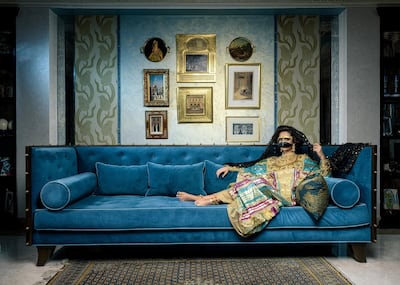
Sheikha Hamda bint Mohammed Al Nahyan, maternal aunt to the President, Sheikh Khalifa, commissioned this dress as a gift to El Mutwalli and instructed the late Fatima bint Saad, a well-known palace dressmaker, to base the design on the style of her own wedding dress. The dress is embroidered on the neckline, central axis and sleeve cuffs with pure gold discs, some of which resemble embossed gold coins.
Look 4: fancy threads
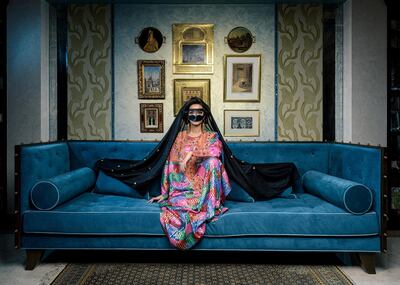
Also from the 1980s, this brocade silk chiffon dress features metallic thread from Japan, which was introduced to the region around this time. The thobe is worn over the kandura. It is embellished with teli work, which has been applied to the neckline and sleeve cuffs. The dress was previously worn by Sheikha Salama bint Hamdan Al Nahyan, wife of Sheikh Mohammed bin Zayed, Crown Prince of Abu Dhabi and Deputy Supreme Commander of the Armed Forces. El Mutwalli saw it being worn on numerous social and official occasions before it was eventually donated to the Sultani collection.
____________________
Read more:
We speak to a master in the art of discretion: Dr Reem El Mutwalli
Dr Karima Alshomely on the inspiration behind The Emirati Burqa exhibition
____________________
